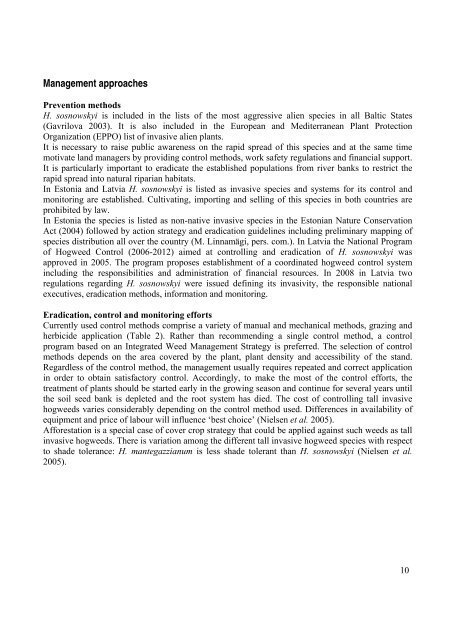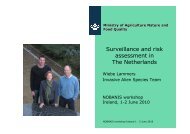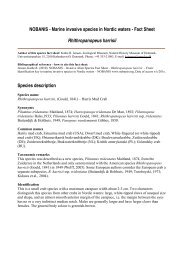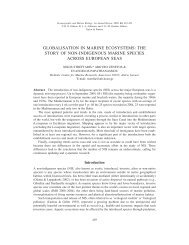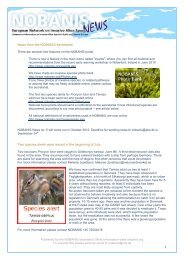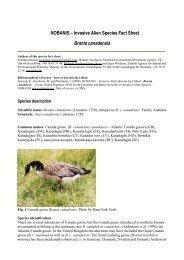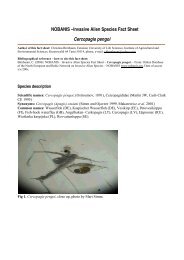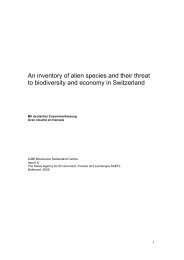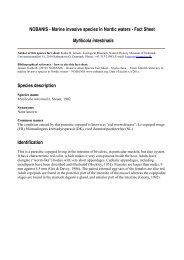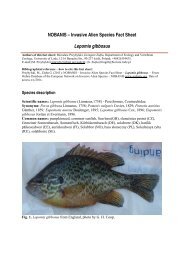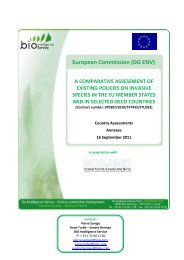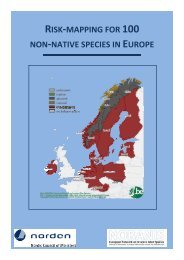NOBANIS – Invasive Alien Species Fact Sheet Heracleum sosnowskyi
NOBANIS – Invasive Alien Species Fact Sheet Heracleum sosnowskyi
NOBANIS – Invasive Alien Species Fact Sheet Heracleum sosnowskyi
You also want an ePaper? Increase the reach of your titles
YUMPU automatically turns print PDFs into web optimized ePapers that Google loves.
Management approaches<br />
Prevention methods<br />
H. <strong>sosnowskyi</strong> is included in the lists of the most aggressive alien species in all Baltic States<br />
(Gavrilova 2003). It is also included in the European and Mediterranean Plant Protection<br />
Organization (EPPO) list of invasive alien plants.<br />
It is necessary to raise public awareness on the rapid spread of this species and at the same time<br />
motivate land managers by providing control methods, work safety regulations and financial support.<br />
It is particularly important to eradicate the established populations from river banks to restrict the<br />
rapid spread into natural riparian habitats.<br />
In Estonia and Latvia H. <strong>sosnowskyi</strong> is listed as invasive species and systems for its control and<br />
monitoring are established. Cultivating, importing and selling of this species in both countries are<br />
prohibited by law.<br />
In Estonia the species is listed as non-native invasive species in the Estonian Nature Conservation<br />
Act (2004) followed by action strategy and eradication guidelines including preliminary mapping of<br />
species distribution all over the country (M. Linnamägi, pers. com.). In Latvia the National Program<br />
of Hogweed Control (2006-2012) aimed at controlling and eradication of H. <strong>sosnowskyi</strong> was<br />
approved in 2005. The program proposes establishment of a coordinated hogweed control system<br />
including the responsibilities and administration of financial resources. In 2008 in Latvia two<br />
regulations regarding H. <strong>sosnowskyi</strong> were issued defining its invasivity, the responsible national<br />
executives, eradication methods, information and monitoring.<br />
Eradication, control and monitoring efforts<br />
Currently used control methods comprise a variety of manual and mechanical methods, grazing and<br />
herbicide application (Table 2). Rather than recommending a single control method, a control<br />
program based on an Integrated Weed Management Strategy is preferred. The selection of control<br />
methods depends on the area covered by the plant, plant density and accessibility of the stand.<br />
Regardless of the control method, the management usually requires repeated and correct application<br />
in order to obtain satisfactory control. Accordingly, to make the most of the control efforts, the<br />
treatment of plants should be started early in the growing season and continue for several years until<br />
the soil seed bank is depleted and the root system has died. The cost of controlling tall invasive<br />
hogweeds varies considerably depending on the control method used. Differences in availability of<br />
equipment and price of labour will influence ‘best choice’ (Nielsen et al. 2005).<br />
Afforestation is a special case of cover crop strategy that could be applied against such weeds as tall<br />
invasive hogweeds. There is variation among the different tall invasive hogweed species with respect<br />
to shade tolerance: H. mantegazzianum is less shade tolerant than H. <strong>sosnowskyi</strong> (Nielsen et al.<br />
2005).<br />
10


